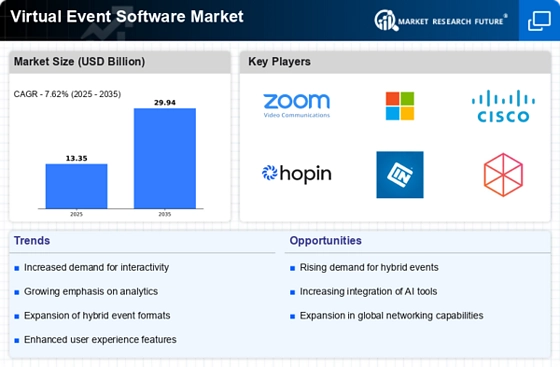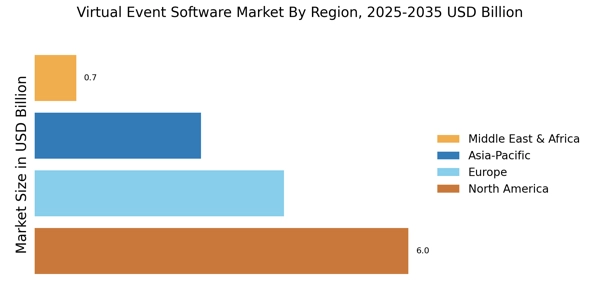The Virtual Event Software Market is currently characterized by a dynamic competitive landscape, driven by rapid technological advancements and an increasing demand for innovative digital solutions. Key players such as Zoom Video Communications (US), Microsoft (US), and Hopin (GB) are strategically positioning themselves to capitalize on these trends. Zoom Video Communications (US) has focused on enhancing user experience through continuous platform upgrades and integrations, while Microsoft (US) leverages its extensive ecosystem to offer seamless virtual event solutions. Hopin (GB), on the other hand, emphasizes community engagement and networking features, which are becoming increasingly vital in virtual environments. Collectively, these strategies not only enhance their market presence but also contribute to a more competitive environment, where differentiation is increasingly based on user experience and technological capabilities.
In terms of business tactics, companies are adopting localized approaches to better serve diverse markets, alongside optimizing their supply chains to ensure reliability and efficiency. The competitive structure of the Virtual Event Software Market appears moderately fragmented, with numerous players vying for market share. However, the influence of major companies is substantial, as they set benchmarks for innovation and customer service, thereby shaping the overall market dynamics.
In August 2025, Zoom Video Communications (US) announced the launch of its new AI-driven analytics tool designed to enhance user engagement during virtual events. This strategic move is significant as it not only positions Zoom as a leader in leveraging artificial intelligence but also addresses the growing need for data-driven insights in event management. By providing organizers with actionable analytics, Zoom aims to improve event outcomes and user satisfaction, thereby reinforcing its competitive edge.
In September 2025, Microsoft (US) unveiled a partnership with a leading event management platform to integrate its Teams application with advanced event planning tools. This collaboration is crucial as it expands Microsoft’s reach within the virtual event space, allowing users to seamlessly transition from planning to execution. The integration is likely to enhance user experience and streamline operations, further solidifying Microsoft’s position in the market.
In July 2025, Hopin (GB) secured a significant investment to enhance its platform capabilities, focusing on immersive experiences through virtual reality (VR) technologies. This investment is indicative of Hopin's commitment to innovation and its understanding of the evolving needs of event organizers and attendees. By incorporating VR, Hopin aims to differentiate itself in a crowded market, potentially attracting a new segment of users seeking more engaging event experiences.
As of October 2025, the competitive trends within the Virtual Event Software Market are increasingly defined by digitalization, sustainability, and the integration of artificial intelligence. Strategic alliances are becoming more prevalent, as companies recognize the value of collaboration in enhancing their service offerings. Looking ahead, it is anticipated that competitive differentiation will increasingly pivot from price-based strategies to a focus on innovation, technological advancements, and the reliability of supply chains. This shift underscores the necessity for companies to continuously evolve and adapt to the changing landscape, ensuring they remain relevant and competitive in a rapidly advancing market.


















Leave a Comment